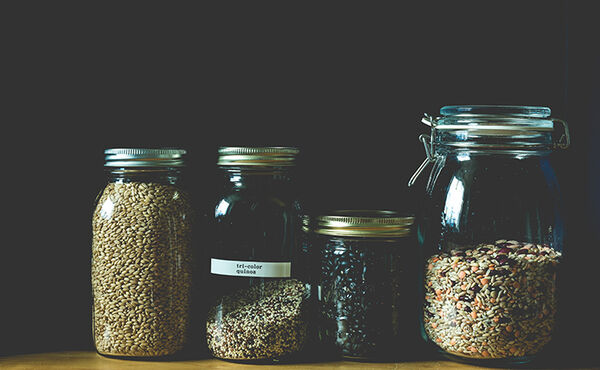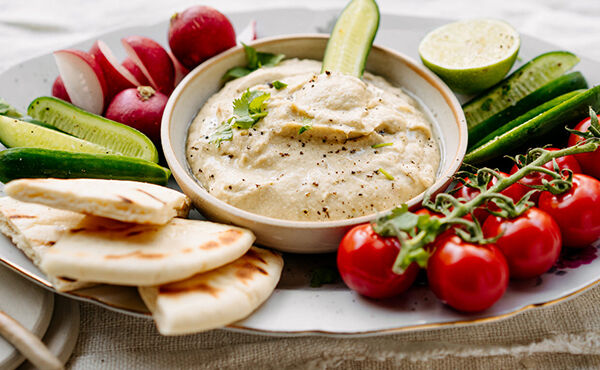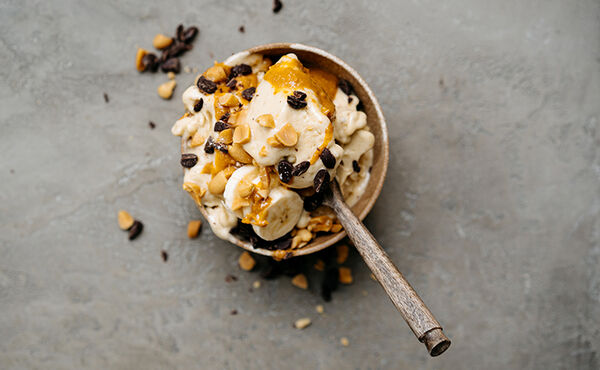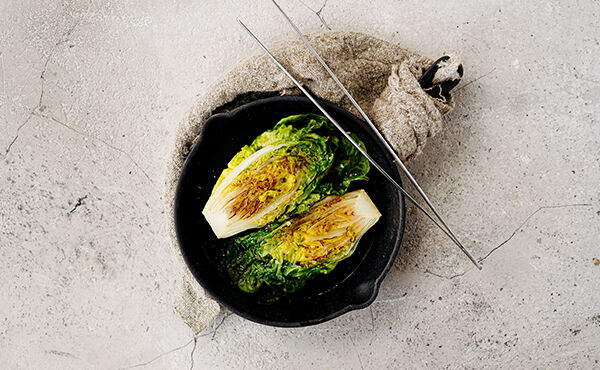The secret to healthy eating? Stocking up on the right ingredients so you can whip up a quick, tasty mealy any time. It’s that simple. It all begins with grocery shopping and filling up your pantry with herbs, spices, whole-grain foods, fresh vegetables, nuts and lots more. Want to know how to build a healthy kitchen? Read all about it below.
Create a healthy base
It all starts with creating a healthy base for your meal that you can draw upon. Stock up your pantry with whole wheat pasta, lentils, rice (for example brown or wild), quinoa, bulgur wheat, millet, sorghum, and buckwheat in Kilner jars. This way, you always have a starting point for your meal when you need to whip something up quickly.
Buy in bulk
Stock up on cans and tins: chickpeas, tomatoes, beans and pulses all come in cans or glass jars and are ideal to buy in bulk, since the expiration date is mostly a year or two after buying (but always check to be sure!). Another great addition to your kitchen pantry is lots of herbs and spices, like Ayurvedic turmeric, cumin, ginger and cardamom.
Go nuts!
Nuts are a great addition to your everyday meal, as they are high in healthy fats and a great source of fibre and protein. This makes them ideal as a snack or to top of a bowl of bulgur with fresh those jars of lentils, rice and other bases. your jars with lentils, rice and other bases you have stocked up on. Many studies have shown that nuts provide various health benefits – especially in regards to reducing heart disease risk factors. Other high-fat foods are avocados, extra virgin olive oil (a must have in your kitchen!), fatty fish (that you stock up on in tins), whole eggs and chia sees.
.jpg?sw=600&sh=370&sm=fit&cx=0&cy=0&cw=730&ch=450&sfrm=jpg)
Make the most of your freezer
Frozen veggies and fruits are rich in nutrients and are handy to save in your freezer as they can be used for smoothies, snacks and homemade acai bowls. Think of frozen mango, all types of berries and pineapple. Also, a pro tip: do you have bananas that are overripe, black and really shrunk – and you need to throw out? Freeze them and turn them into a delicious, creamy vegan banana ice cream! Veggies that are great frozen are, for instance, peas, carrots, cauliflower and green beans as you can throw them into recipes like chili, stews and soups for added nutrients and flavour.
Kitchen essential
Olive oil is an essential ingredient in every kitchen. Great (if not essential) to add to a bowl of quinoa and veggies, to wholewheat pasta, or to dip your bread in with some salt. Even better is herb infused olive oil – and super easy to make. Just add some herbs in an ice cube tray, add some olive oil and garlic et voila; ready to go in the freezer. Take a cube out of the freezer when you are ready to cook - the flavour combinations are endless.
Stocks, broths and foodie tricks
Soup stocks and broths are pantry essentials, as they are very easy to make and to preserve at home. Basic ingredients for any kind of stock are celery, onion and carrot. You can also add additional ingredients such as meat, poultry, fish or bones and aromatics such as thyme, cloves and black peppercorns. There are many vegetable and herb scraps that you may have been tossing out that make an excellent base for your soup, like celery leaves, carrot leaves and ends, parsley stems, the green part of leeks, onion ends and skins, tomato ends and thyme and oregano stems (after you’ve stripped the leaves). The bones that are left over after cooking poultry, meat and fish are also perfect to make stock from. This is also a great way to avoid food waste. Want to know more about it? Here are 6 foodie tricks that are healthy for you and the planet.

Shopping seasonally
There are lots of advantages when buying seasonally. The food tastes better when it’s grown in its natural season, the food is cheaper to buy and last but not least: seasonal food is better for the environment. Growing and transporting food so that it is always available uses a lot of energy that creates CO2, and this greenhouse gas is harmful to the environment.
The best part
So, now your healthy kitchen is all set. What comes next is the best part: let’s get cooking! It’s all about trial and error (and lots of taste tests, of course) and looking online for recipe inspiration. Check out Sophia Roe (Sophia_Roe on Instagram) for example: this NYC cook makes delicious recipes and is very smart about using all parts of food and not wasting anything. Hungry yet? Give her corn broth a try, or start off with her recipe for delicious cauliflower skewers with herby, saucy olive-ish goodness. We also have a host of recipes, most recently from head chef at Rouhi, Renaud Goigoux, so be sure to check them out too.
Happy cooking!
.jpg?sw=1440&sh=445&sm=fit&cx=0&cy=0&cw=1440&ch=445&sfrm=jpg)



.jpg?sw=600&sh=370&sm=fit&cx=0&cy=0&cw=600&ch=370&sfrm=jpg)
.jpg?sw=600&sh=370&sm=fit&cx=0&cy=0&cw=600&ch=370&sfrm=jpg)